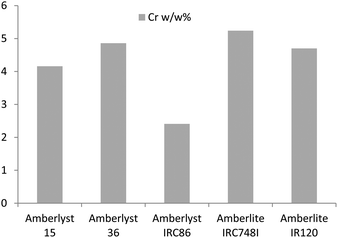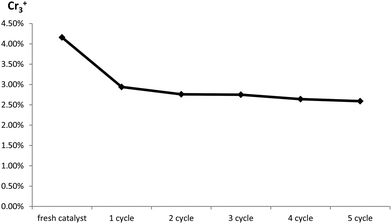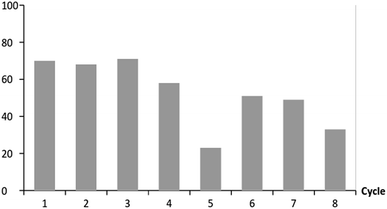 Open Access Article
Open Access ArticleCreative Commons Attribution 3.0 Unported Licence
Bifunctional Cr3+ modified ion exchange resins as efficient reusable catalysts for the production and isolation of 5-hydroxymethylfurfural from glucose†
Joao M. J. M.
Ravasco
a,
Jaime A. S.
Coelho
 a,
Svilen P.
Simeonov
*ab and
Carlos A. M.
Afonso
a,
Svilen P.
Simeonov
*ab and
Carlos A. M.
Afonso
 *a
*a
aThe Research Institute for Medicines (iMed.ULisboa), Faculty of Pharmacy, University of Lisbon, Av. Prof. Gama Pinto, 1649-003, Lisboa, Portugal. E-mail: carlosafonso@ff.ulisboa.pt
bInstitute of Organic Chemistry with Centre of Phytochemistry, Bulgarian Academy of Sciences, Acad. G. Bonchev str., bl. 9, 1113, Sofia, Bulgaria. E-mail: svilen@orgchm.bas.bg
First published on 7th December 2016
Abstract
Cr3+ modified readily available cation exchange resins were prepared and explored as heterogeneous bifunctional catalysts for the dehydration of glucose to 5-hydroxymethylfurfural (HMF) in tetraethyl ammonium bromide (TEAB)/water as reaction medium. Excellent HMF isolated yields of up to 70% were achieved using simple crystallization of the reaction medium (TEAB) from ethyl acetate/ethanol which allowed the isolation of HMF in high purity. The best identified catalyst (Amberlyst 15/Cr3+) exhibited high activity over 4 cycles. The loss of activity was attributed to the decreased number of acidic sites of the catalyst, thus a simple treatment of the catalyst with 10% HCl efficiently restored its activity in the following cycles.
Introduction
Nowadays, biorefinery is considered the most promising approach that may gradually replace current dependence on fossil resources, which although cheap and easy to obtain, lack any sustainability in comparison with biorefinery. Among other building blocks derived from renewable resources such as ethanol, glycerol, lactic acid and furfural, 5-hydroxymethylfurfural (HMF) has been recognized as a key biorefining building block derived from carbohydrates, such as cellulose, glucose, inulin, fructose, etc. Among them, fructose is currently the only carbohydrate that can be readily dehydrated into HMF, typically in high yield and selectivity.1,2 However, fructose has a low abundance in nature resulting in high cost and very importantly is used in the food sector. In contrast, glucose has much higher abundancy and is readily available from non-food cellulosic biomass, thus being a highly desirable feedstock.3 However, due to its resistance to dehydration and formal carbonyl isomerization, the development of catalytic systems and processes that could efficiently convert glucose into HMF is more demanding being still an open topic. It is known that generally the conversion of glucose to HMF is a two-step process where first the glucose is isomerized to fructose and the last undergoes subsequent dehydration to form HMF. The isomerization step is typically enzymatic, base or metal salt catalysed, while dehydration is an acid catalysed process. In the recent years a considerable number of bifunctional catalysts have been reported allowing this one pot transformation.Some metal salts were reported to effectively promote the isomerization and dehydration of glucose. Among several metal salts such as metal oxides4–6 and phosphates,7–9 chlorides and, in particular, chromium chlorides, proved to be highly effective to promote the isomerization and dehydration of glucose. Zhang et al.10 reported the first example of CrCl2 catalysed dehydration of glucose achieving nearly 70% HMF yield using the ionic liquid 1-ethyl-3-methylimidazolium chloride at 100 °C. After this pioneer work, many reports emerged describing the use of chromium chlorides as catalysts for glucose dehydration. Yong et al.11 reported NHC–CrCl3/1-butyl-3-methylimidazolium chloride ([bmim]Cl) system capable of converting glucose into HMF in up to 81% yield. In 2009, Zhao et al.12 described the microwave accelerated glucose dehydration catalysed by CrCl3 in [bmim]Cl, yielding HMF in up to 91% yield. CrCl3/tetraethylammonium chloride system was reported by Lin et al.13 that efficiently catalyse the glucose dehydration and was achieved an HMF yield of 71%.
It is known solvent plays a key role in the chromium catalysed dehydration of glucose to HMF, and high conversion and selectivity are usually achieved using ionic liquids as reaction media, as explained by Hensen et al.14 the presence of highly concentrated and mobile chloride anions from the ionic liquid promotes the (de)protonation reactions important for the glucose isomerization (Scheme 1).
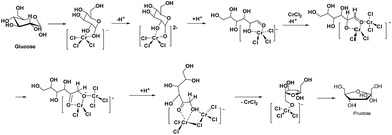 | ||
| Scheme 1 Proposed mechanism of the Cr2+ promoted glucose–fructose isomerization in ionic liquids.14 | ||
The problematic downstream separation of HMF from high-boiling organic solvents or ionic liquids and the toxicity and pollution of chromium in the environment decreases the attractiveness as a biorefinery process. As a results, several strategies to overcome these drawbacks were reported. Yang et al.15 reported recyclable SO3H/CrCl3 bifunctional polymeric ionic liquids for carbohydrates dehydration to HMF in H2O:DMSO/MIBK:n-BuOH biphasic systems. Up to near 49% HMF yield was achieved, nevertheless the recyclability of these catalysts in case of glucose was not described. Zhang et al.16 achieved 43% HMF yield from glucose using heterogeneous chromium-exchanged zirconium phosphate catalyst in [bmim]Cl. However, this result was obtained only after 12 h reaction time and no catalyst recycling reactions were reported. More recently Jiang et al.17 reported Cr3+ modified ion exchange resins to effectively promote glucose dehydration in [bmim]Cl ionic liquid. D001-cc resin modified with CrCl3 exhibited the best performance and up to 70% HMF yield have been achieved. The catalyst was recycled over 6 cycles and decreasing yields were observed after each cycle. Nevertheless, HPLC yields were reported and not isolated.
Besides all the achievements reported so far, the development of a glucose dehydration process that will allow both easy isolation of HMF from the reaction media and recyclability of the catalysts from both economic and environmental point of view is still an open topic. Previously, we reported that tetraethyl ammonium bromide (TEAB)/water is an efficient reaction media for fructose dehydration, which allowed quantitative HMF isolation via simple TEAB crystallization and subsequent recycling of both TEAB and organic solvents.18,19 Nevertheless, under the optimised conditions for fructose, we were able to achieve only 35% HMF yield from glucose using CrCl3 as catalysts under homogeneous conditions. Later, we demonstrated that TEAB/water reaction media proved to be highly efficient for two-step integrated chemo-enzymatic production of HMF from glucose. Using this approach 87% isolated HMF yield from glucose was achieved,20 which to the best of our knowledge still remains among the highest reported yields as stated in a recent review.21
The constructing an efficient and recyclable one-pot process for glucose transformation to HMF using the already proven TEAB/water reaction media is still challenging. Here in, a series of cheap and readily available acidic cation exchange resins modified with Cr3+ were prepared and used as bifunctional heterogeneous catalysts in one pot glucose dehydration in TEAB/water reaction media. The previously developed crystallization method for HMF isolation was used allowing both quantitative isolation of HMF from the reaction media and reuse of the catalyst.
Results and discussion
It is known that acidic ion-exchange resins are successfully applied for adsorptive removal of Cr3+.22,23 Encouraged by that, we envisioned the preparation of Cr3+ modified ion exchange resins as promoters for the glucose dehydration. A series of such catalysts was obtained by adsorption of Cr3+ over ion-exchange resins in MeOH solutions. The prepared catalysts were characterized by ICP-AES analyses and the Cr loading was calculated in w/w%. Amberlyst 15, Amberlyst 36 and Amberlite IR120 exhibit similar results 4.16%, 4.86% and 4.70% respectively. As it was expected the highest Cr loading of 5.24% was observed for Amberlite IRC748I being a chelating resin, while only 2.41% loading was achieved with IRC86 (Fig. 1). The catalytic conversion of glucose to HMF was performed using mover para o final da frase talvez TEAB/water (10% w/w) reaction media.19 As expected, due to the higher dehydration resistance of glucose compared to fructose, longer reaction times and higher catalyst loading were required. However, even after 60 min reaction time at 100 °C, using Amberlyst 15/Cr3+ 100% (w/w, glucose/catalyst) loading only 34% yield was achieved. Nevertheless, our previous observations about the importance of small amounts of water (10–15%) in the reaction media to achieve clean conversion were confirmed and outstanding purity of 99% was obtained. In the following experiments the effect of temperature was studied by rising in 10 °C steps. The highest HMF yield of 70% with outstanding purity of 98% was achieved at 120 °C. Using Amberlyst 15 without Cr3+ under these conditions the HMF yield was only 24%. Further increase of the temperature to 130 °C was not beneficial and decreased yield of 55% was observed probably due to the unstable nature of HMF at high temperatures (Fig. 2). Using lower catalyst loading of 50% (w/w) resulted in a lower yield of 59%, thus 100% (w/w) was established as optimal for the further experiments.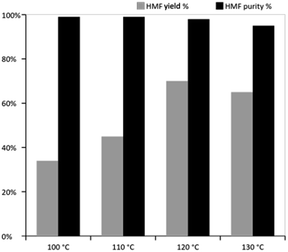 | ||
| Fig. 2 Glucose dehydration under different temperatures. Reaction conditions: Amberlyst 15/Cr3+ (0.7 g), glucose (0.7 g), water (0.7 mL), TEAB (7 g), 60 min. | ||
Further optimization of the reaction time was performed. However, prolonged reaction times of 75 min and 120 min resulted in lower yields of 68% and 64% and purity of 91% and 92% respectively (Fig. 3).
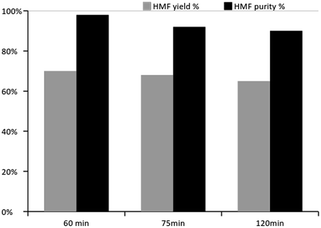 | ||
| Fig. 3 Glucose dehydration under different reaction times. Reaction conditions: Amberlyst 15/Cr3+ (0.7 g), glucose (0.7 g), water (0.7 mL), TEAB (7 g), 120 °C. | ||
With the optimized conditions in hands for Amberlyst 15, we studied the catalytic activity of the other Cr3+ modified Amberlyst 36, Amberlyst IRC86, Amberlite IRC748I and Amberlite IR120 resins (Fig. 4). No direct correlation between Cr loadings and observed yields have been noticed. Surprisingly the two Cr3+ modified ion exchange resins with the highest Cr loadings Amberlite IR120/Cr3+ (4.70%) and Amberlite IRC748I/Cr3+ (5.24%) provided very low yields of only 10% and 27% respectively. Similar yield of 62% as for Amberlyst 15/Cr3+ was achieved with Amberlyst 36/Cr3+. Amberlyst IRC86/Cr3+ which exhibited the lowest Cr loading of only 2.41% provided almost identical yield of 68%, thus leading to the idea that very low amounts of Cr are sufficiently catalysing glucose to fructose isomerization. However, considering the all process a good balance between Cr loading and acidity of the catalyst is important. It is worthy to be mentioned that although considerable variation of the yields was observed for different resins, the HMF was isolated in high purities of above 98% in all cases (Fig. 4).
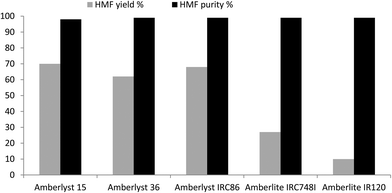 | ||
| Fig. 4 Glucose dehydration using different Cr3+ modified cation exchange resins. Reaction conditions: catalyst (0.7 g), glucose (0.7 g), water (0.7 mL), TEAB (7 g), 120 °C, 60 min. | ||
Amberlyst 15/Cr3+ was selected as the best catalyst to study its reusability under optimized conditions. Minimal mechanical destruction of the catalysts was observed over the full set of cycles, when the stirring was precisely controlled to not overcome 600 rpm. High catalytic activity and repetitive yield of close to 70% was observed over the first 3 cycles, while low decrease of the yield to 59% was observed over the fourth cycle. However, the yield rapidly decreases to only 25% in the fifth cycle. The leaching of the Cr3+ was followed by ICP analysis of the reaction mixture and the recovered catalyst after each cycle. The leaching in the reaction mixture over the first cycle was determined to be 29%. However, over the second cycle it dramatically decrease to only 1.5%, which can be attributed to the fact that non-absorbed Cr3+ was not sufficiently removed during the catalyst pretreatment. The overall leaching of the following cycles 3–5 was determined to be 5% and average of 1.7% per cycle. The same was observed from the ICP analysis of the recovered Amberlyst 15/Cr3+ (Fig. 5). The Cr3+ loading decrease from 4.16 to 2.94% over the first cycle and further slowly drop down to 2.59% over the cycles 2–5. We assumed that the significant loss of catalytic activity after the 5th cycle can be attributed to the decrease of the acid sites of the catalysts since as we already observed that on one hand only small amounts of Cr are sufficient to promote the first step of the reaction, and on the other hand the determined Cr3+ leaching was minimal, thus after the fifth cycle the catalysts was regenerated using simple treatment with 10% aq. HCl. The use of the regenerated catalyst resulted in 50% yield in the sixth cycle which decreased to 35% in the eight cycle. It is worthy to be mentioned that restoring the catalytic activity using 10% aq. HCl was used as a proof of concept and no optimizations were performed, thus suggesting that full recovering of the catalytic activity may be possible upon further optimization (Fig. 6).
Experimental
General
All chemicals and solvents were purchased from Sigma-Aldrich, Alfa Aesar and Merck and used as received, unless otherwise noted. Et4NBr Sigma Aldrich 14023-1 kg (water content 1% w/w), Amberlyst 15 hydrogen form wet Sigma Aldrich 216399, Amberlyst 36 Sigma Aldrich 436712, Amberlite IR120 hydrogen form hydrogen form Sigma Aldrich 10322, Amberlite IRC86 hydrogen form Sigma Aldrich 06455, Amberlite IRC748I Sigma Aldrich 13296-U SUPELCO, D(+)-glucose anhydrous Merck Art. 8337. HPLC analysis were performed using Dionex P680 pump, Dionex UVD 340S diode array detector, detection at 275 nm, manual injector with 20 μl loop, column HICHROM C18, 250 × 4.6 mm, Rt (HMF) = 9.5 min or Kromasil 100, C18, 250 × 4.6 mm. Rt (HMF) = 11.4 min. Mobile phase gradient from 1![[thin space (1/6-em)]](https://www.rsc.org/images/entities/char_2009.gif) :
:![[thin space (1/6-em)]](https://www.rsc.org/images/entities/char_2009.gif) 99 to 50
99 to 50![[thin space (1/6-em)]](https://www.rsc.org/images/entities/char_2009.gif) :
:![[thin space (1/6-em)]](https://www.rsc.org/images/entities/char_2009.gif) 50 for 40 min acetonitrile
50 for 40 min acetonitrile![[thin space (1/6-em)]](https://www.rsc.org/images/entities/char_2009.gif) :
:![[thin space (1/6-em)]](https://www.rsc.org/images/entities/char_2009.gif) water, flow 1 mL min−1, the purity of HMF was determined by comparing the obtained integration area of HMF with other observed minor peaks.
water, flow 1 mL min−1, the purity of HMF was determined by comparing the obtained integration area of HMF with other observed minor peaks.
NMR spectra were recorded at room temperature in a Bruker AMX 300 using CDCl3 as solvent.
ICP analyses were performed on radial Horiba Jobin-Yvon, Ultima ICP-AES equipped with Czerny-Turner monochromator and 40.68 MHz RF generator.
Catalysts preparation
All the catalysts were prepared as follows – a pressure glass reactor tube (Fig. S4†) (15 mL, Aldrich Z181064) was charged with 3 g of the corresponding resin and 1 g CrCl3·6H2O, 10 mL MeOH was added and the mixture was heated without stirring at 80 °C overnight. After cooling down the Cr3+ modified resins were filtered and washed subsequently with 100 mL of water and 100 mL of MeOH prior dried in open air for 12 h.Catalysts characterisation
To approximately 100 mg of the corresponding Cr3+ ion exchange resin were added 0.6 mL 35% aq. HCl and 0.2 mL 69% aq. HNO3. Then, the sample was heated at 120 °C for 180 min. The obtained homogeneous solution was transferred into a 5 mL volumetric flask and filled with deionized water. 1 mL of the resulting solution was transferred in 100 mL volumetric flask and diluted with deionized water. The ICP-AES analyses were performed using the following conditions: RF power 1050 kW, coolant gas flow rate (Ar) 12 mL min−1, nebulizer Mira Mist with 3 bar pressure, sample flow rate 1.0 mL min−1, wavelength 267.716 nm.General procedure for catalytic dehydration of glucose into HMF
A pressure glass reactor tube (Fig. S4†) (15 mL, Aldrich Z181064) was charged with the catalyst (0.7 g), glucose (0.7 g, 3.885 mmol), water (0.7 mL), tetraethylammonium bromide (TEAB) (7 g) and the resulting mixture was stirred magnetically at 600 rpm using a cross-shaped magnetic stirrer and heated with a thermostatically controlled (0.1 °C) oil bath at a certain temperature for a specific time. Upon cooling to room temperature, the mixture was dissolved in absolute ethanol (20 mL) and the catalyst was filtered and washed with absolute ethanol (20 mL). The solvent was evaporated under vacuum and the resulting solid was then dissolved in hot absolute ethanol (3.5 mL). The clear solution was then precipitated with ethyl acetate (200 mL), stirred for 20 minutes and filtered off over a pad of silica (10 g) to yield HMF as a brownish liquid, which solidifies in freezer (−12 °C). The product purity was analyzed by HPLC and 1H NMR.Recycling experiments and catalyst reactivation
The recycling experiments were performed using the described general procedure, the recovered Amberlyst 15/Cr3+ catalyst was directly used in the next cycle upon drying under vacuum for 1 h (0.1 mbar).The Amberlyst 15/Cr3+ catalyst isolated from the fifth cycle was reactivated using the following procedure: the catalyst and 14 mL of 10% HCl were charged into 50 mL round-bottomed flask and stirred at room temperature for 1 h. The catalyst was filtered, washed with absolute ethanol (15 mL) and dried under vacuum (0.1 mbar, 1 h) and used in the following cycles without further treatment.
Conclusions
In conclusion, a highly efficient approach for the direct transformation of glucose to HMF that addresses both isolation and environmental issues related with the use of Cr3+ catalysis was described. Five Cr3+ modified readily available cation exchange resins were prepared and explored as heterogeneous bifunctional catalysts for this transformation. Among them Amberlyst 15/Cr3+ exhibit the best performance and was successfully recycled over 4 cycles, while significant decrease of the catalytic activity was observed only in the 5th cycle. However, the loss of catalytic activity could be overcome by simple regeneration of the acidic sites of the catalyst. The already optimized in our previous studies of TEAB/water reaction media proved to be highly efficient allowing easy HMF isolation in high purity, thus providing superior alternative to the commonly used ionic liquids.Acknowledgements
The authors acknowledge Fundação para a Ciência e a Tecnologia (FCT) (ref. SFRH/BPD/109476/2015, SFRH/BPD/100433/2014 and UID/DTP/04138/2013), European Research Area Network; ERANet LAC (ref. ELAC2014/BEE-0341), and REDE/1518/REM/2005 (FF-UL) for the mass service.Notes and references
- A. A. Rosatella, S. P. Simeonov, R. F. M. Frade and C. A. M. Afonso, Green Chem., 2011, 13, 754 RSC.
- R.-J. van Putten, J. C. van der Waal, E. de Jong, C. B. Rasrendra, H. J. Heeres and J. G. de Vries, Chem. Rev., 2013, 113, 1499 CrossRef CAS PubMed.
- J. Wang, J. Xi and Y. Wang, Green Chem., 2015, 17, 737 RSC.
- M. Zhang, K. Su, H. Song, Z. Li and B. Cheng, Catal. Commun., 2015, 69, 76 CrossRef CAS.
- F. Yang, Y. Li, Q. Zhang, X. Sun, H. Fan, N. Xu and G. Li, Carbohydr. Polym., 2015, 131, 9 CrossRef CAS PubMed.
- L. Atanda, S. Mukundan, A. Shrotri, Q. Ma and J. Beltramini, ChemCatChem, 2015, 7, 781 CrossRef CAS.
- J. Teng, H. Ma, F. Wang, L. Wang and X. Li, BioResources, 2016, 11, 2152 CrossRef CAS.
- P. Daorattanachai, P. Khemthong, N. Viriya-empikul, N. Laosiripojana and K. Faungnawakij, Carbohydr. Res., 2012, 363, 58 CrossRef CAS PubMed.
- A. Dutta, A. K. Patra, S. Dutta, B. Saha and A. Bhaumik, J. Mater. Chem., 2012, 22, 14094 RSC.
- H. Zhao, J. E. Holladay, H. Brown and Z. C. Zhang, Science, 2007, 316, 1597 CrossRef CAS PubMed.
- G. Yong, Y. Zhang and J. Y. Ying, Angew. Chem., Int. Ed., 2008, 47, 9345 CrossRef CAS PubMed.
- C. Li, Z. Zhang and Z. K. Zhao, Tetrahedron Lett., 2009, 50, 5403 CrossRef CAS.
- L. Hu, Y. Sun and L. Lin, Ind. Eng. Chem. Res., 2012, 51, 1099 CrossRef CAS.
- E. A. Pidko, V. Degirmenci, R. A. van Santen and E. J. M. Hensen, Angew. Chem., Int. Ed., 2010, 49, 2530 CrossRef CAS PubMed.
- H. Li, Q. Zhang, X. Liu, F. Chang, Y. Zhang, W. Xue and S. Yang, Bioresour. Technol., 2013, 144, 21 CrossRef CAS PubMed.
- B. Liu, C. Ba, M. Jin and Z. Zhang, Ind. Crops Prod., 2015, 76, 781 CrossRef CAS.
- H. Liu, H. Wang, Y. Li, W. Yang, C. Song, H. Li, W. Zhu and W. Jiang, RSC Adv., 2015, 5, 9290 RSC.
- S. P. Simeonov, J. A. S. Coelho and C. A. M. Afonso, ChemSusChem, 2012, 5, 1388 CrossRef CAS PubMed.
- J. A. S. Coelho, S. P. Simeonov and C. A. M. Afonso, Org. Synth., 2016, 93, 29 CrossRef.
- S. P. Simeonov, J. A. S. Coelho and C. A. M. Afonso, ChemSusChem, 2013, 6, 997 CrossRef CAS PubMed.
- T. Wang, M. W. Nolte and B. H. Shanks, Green Chem., 2014, 16, 548 RSC.
- S. Mustafa, K. H. Shah, A. Naeem, T. Ahmad and M. Waseem, Desalination, 2010, 264, 108 CrossRef CAS.
- S. Kocaoba and G. Akcin, Desalination, 2005, 180, 151 CrossRef CAS.
Footnote |
| † Electronic supplementary information (ESI) available. See DOI: 10.1039/c6ra22539j |
| This journal is © The Royal Society of Chemistry 2017 |

